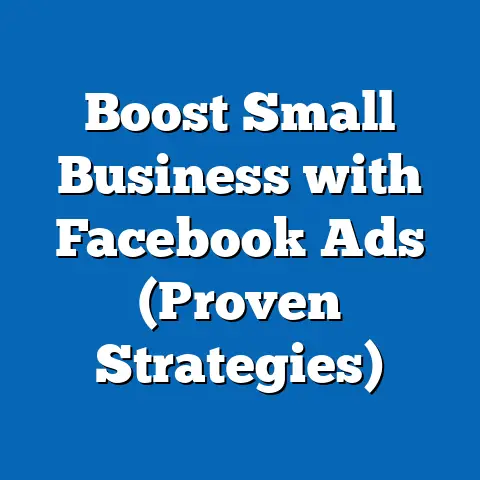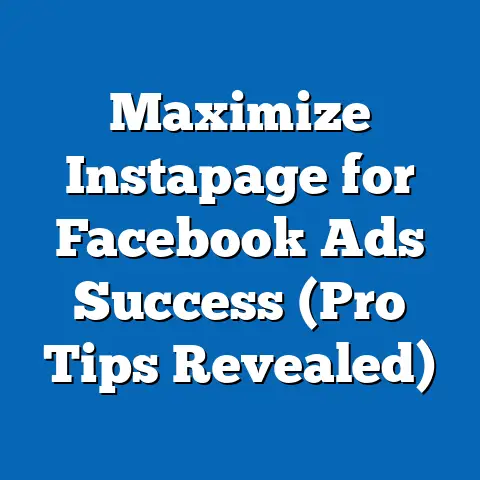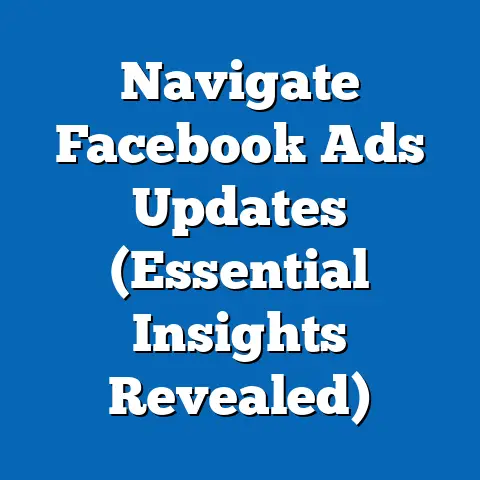Mastering Facebook Ads Billing Thresholds (Insider Tips)
I remember the first time I dove headfirst into Facebook advertising. The excitement was palpable. I envisioned connecting with thousands of new customers, watching my brand explode in popularity, and finally achieving the kind of growth I had only dreamed of. I launched my first campaign, a simple ad showcasing a new product, and eagerly awaited the results.
But the journey wasn’t as smooth as I had anticipated. The initial thrill quickly turned into a mix of confusion and anxiety. I was constantly checking the Ads Manager, trying to decipher the metrics, and feeling increasingly vulnerable as my budget dwindled. Unexpected costs popped up, my ads weren’t performing as well as I hoped, and I felt like I was throwing money into a black hole. I remember one particularly stressful week when I was hit with an unexpectedly large bill, throwing my carefully planned budget completely off track. That’s when I realized I needed to get a handle on the financial side of Facebook advertising, and fast.
It was during this period of trial and error that I stumbled upon the concept of Facebook Ads billing thresholds. Understanding and mastering these thresholds, I discovered, was the key to not only managing my ad spend effectively but also achieving financial peace of mind. It allowed me to regain control of my campaigns, optimize my budget, and ultimately, drive better results.
What Are Facebook Ads Billing Thresholds?
Billing thresholds are a crucial aspect of Facebook advertising that directly impacts how and when you’re charged for your ad spend. Think of them as pre-set spending limits that trigger a charge from Facebook. They’re designed to help you manage your budget and prevent runaway spending.
In essence, a billing threshold is a specific amount of money that you can spend on your Facebook ads before Facebook charges your payment method. Once your ad spend reaches this threshold, Facebook will automatically charge you for the accumulated costs. The threshold then resets, allowing you to continue running ads until you reach the next billing threshold.
It’s important to understand how billing thresholds fit into the broader context of your ad campaigns. You set daily or lifetime budgets for your ads, which dictate the maximum amount you’re willing to spend over a specific period. Billing thresholds, on the other hand, determine when those costs are actually charged to your account.
For example, let’s say you set a daily budget of $50 for your ad campaign and your billing threshold is $25. Even though your daily budget allows you to spend up to $50 per day, Facebook will charge your payment method as soon as your accumulated ad spend reaches $25.
This can have a significant impact on cash flow, especially for small businesses and marketers who are operating on tight budgets. By understanding and managing your billing thresholds, you can better predict when you’ll be charged and avoid unexpected financial surprises.
Key Takeaway: Billing thresholds are pre-set spending limits that trigger a charge from Facebook. Understanding them is crucial for managing your ad spend and cash flow.
How Facebook Determines Your Billing Threshold
Facebook’s algorithm for setting billing thresholds is a bit of a black box, but I’ve observed some key factors that seem to influence the initial amount and how it changes over time.
The initial billing threshold is typically determined by a combination of factors, including:
- Ad Spend History: If you’re new to Facebook advertising, your initial billing threshold will likely be quite low, perhaps around $25 or $50. As you consistently run ads and demonstrate responsible spending habits, Facebook may gradually increase your threshold.
- Payment Method: The payment method you use can also impact your billing threshold. Credit cards are generally seen as more reliable than debit cards, which can lead to a higher initial threshold.
- Account Status: A clean account history, with no payment issues or policy violations, will contribute to a higher initial threshold. Conversely, a history of late payments or policy violations can result in a lower threshold or even ad account restrictions.
As you build trust with Facebook through consistent ad performance and timely payments, you can expect your billing thresholds to increase over time. This is Facebook’s way of rewarding responsible advertisers and allowing them to scale their campaigns without constant interruptions for billing.
I remember when I first started, my billing threshold was a measly $25. I had to constantly monitor my ad spend and make payments to avoid having my ads paused. But as I ran more campaigns, consistently paid my bills on time, and adhered to Facebook’s advertising policies, my billing threshold gradually increased. Eventually, I reached a point where my threshold was high enough that I could run my campaigns without worrying about frequent billing interruptions.
Key Takeaway: Facebook determines your billing threshold based on factors like ad spend history, payment method, and account status. Building trust with Facebook through responsible advertising habits can lead to higher thresholds.
The Importance of Monitoring Your Billing Thresholds
Monitoring your billing thresholds is not just a good practice; it’s essential for maintaining control over your ad campaigns and avoiding unexpected financial surprises.
Failing to keep an eye on your billing thresholds can lead to a number of negative consequences:
- Unexpected Charges: If you’re not aware of your current billing threshold, you could be hit with unexpected charges that throw your budget off track.
- Interrupted Ad Delivery: When you reach your billing threshold, Facebook will automatically charge your payment method. If the payment fails for any reason (e.g., insufficient funds, expired card), your ads will be paused until the issue is resolved. This can disrupt your campaign momentum and negatively impact your results.
- Missed Opportunities: If you’re running time-sensitive promotions or campaigns, having your ads paused due to billing issues can lead to missed opportunities and lost revenue.
By actively monitoring your billing thresholds, you can preemptively adjust your budgets and strategies to maintain campaign momentum. For example, if you know that your billing threshold is approaching, you can reduce your daily budget to avoid reaching it too quickly. Alternatively, you can ensure that your payment method is up-to-date and that you have sufficient funds to cover the upcoming charges.
Key Takeaway: Monitoring your billing thresholds is crucial for avoiding unexpected charges, preventing interrupted ad delivery, and capitalizing on time-sensitive opportunities.
Insider Tips for Mastering Your Billing Thresholds
Now, let’s dive into some actionable tips that I’ve learned over the years for mastering your Facebook Ads billing thresholds:
- Tip 1: Regularly Review and Adjust Your Spending Limits Based on Performance Metrics. Don’t just set your budget and forget about it. Regularly review your campaign performance and adjust your spending limits accordingly. If your ads are performing well, you may want to increase your budget to capitalize on the momentum. Conversely, if your ads are underperforming, you may want to decrease your budget to avoid wasting money.
- Tip 2: Utilize the Facebook Ads Manager to Track Spending and Billing Cycle. The Facebook Ads Manager provides a wealth of information about your ad spend and billing cycle. Take advantage of these tools to track your spending, monitor your billing thresholds, and anticipate upcoming charges. Pay close attention to the “Billing Summary” section, which provides a detailed breakdown of your ad spend and payment history.
- Tip 3: Establish a Routine for Monitoring Account Performance and Billing Thresholds, Especially Before Launching New Campaigns. Make it a habit to check your account performance and billing thresholds on a regular basis, especially before launching new campaigns. This will help you ensure that you have sufficient funds to cover your ad spend and that your payment method is up-to-date.
- Tip 4: Understand the Implications of Changing Payment Methods on Your Billing Thresholds. Changing your payment method can impact your billing threshold. If you switch from a credit card to a debit card, for example, your threshold may be lowered. Be sure to factor this into your budget planning and adjust your spending limits accordingly.
I’ve seen firsthand how these tips can make a difference. One of my clients, a small e-commerce business, was struggling to manage their Facebook ad spend. They were constantly being hit with unexpected charges and having their ads paused due to billing issues. After implementing these strategies, they were able to gain control of their budget, avoid interruptions in ad delivery, and ultimately, drive better results.
Key Takeaway: Mastering your billing thresholds requires a proactive approach. Regularly review your spending limits, utilize the Facebook Ads Manager, establish a monitoring routine, and understand the implications of changing payment methods.
Dealing with Billing Threshold Challenges
Even with the best planning and monitoring, challenges can still arise when dealing with Facebook Ads billing thresholds. Here are some common issues and how to address them:
- Unexpected Charges: Sometimes, you may encounter unexpected charges that you weren’t anticipating. This could be due to a variety of factors, such as an increase in your billing threshold, a change in your ad delivery settings, or even a billing error. If you encounter an unexpected charge, the first step is to review your ad spend and billing history in the Facebook Ads Manager. If you believe the charge is incorrect, contact Facebook support to dispute it.
- Payment Declines: Payment declines can also be a frustrating issue. This could be due to insufficient funds, an expired card, or even a temporary issue with your bank. If your payment is declined, Facebook will typically notify you and give you the opportunity to update your payment method or resolve the issue. It’s important to address payment declines promptly to avoid having your ads paused.
One of the most valuable lessons I’ve learned is the importance of proactive communication with Facebook support. If you’re facing a billing issue, don’t hesitate to reach out to them for assistance. They can often provide valuable insights and help you resolve the problem quickly.
Key Takeaway: Challenges with billing thresholds are inevitable, but they can be overcome with proactive communication with Facebook support and a willingness to adapt your strategies.
The Future of Facebook Ads Billing
As Facebook continues to evolve its advertising platform, it’s likely that billing thresholds will also undergo changes. I anticipate that Facebook will continue to refine its algorithm for setting billing thresholds, taking into account a wider range of factors, such as ad quality, user engagement, and overall account health.
It’s also possible that Facebook may introduce new billing options or features that give advertisers more control over their ad spend. For example, they could offer the ability to set custom billing thresholds or to receive notifications when their ad spend is approaching a threshold.
Regardless of how billing thresholds evolve, one thing is certain: understanding them will remain a vital skill for marketers in the ever-changing digital landscape. As Facebook continues to be a dominant force in online advertising, mastering the intricacies of its billing system will be essential for achieving success.
Key Takeaway: The future of Facebook Ads billing is uncertain, but understanding billing thresholds will remain a vital skill for marketers in the ever-changing digital landscape.
Conclusion: The Emotional Journey Continues
Mastering Facebook Ads is an emotional rollercoaster. There are highs and lows, moments of excitement and moments of frustration. But through it all, it’s important to remember that understanding billing thresholds is not just about managing finances; it’s about empowering yourself to feel confident in your advertising strategies.
By taking control of your ad spend, avoiding unexpected charges, and maintaining campaign momentum, you can focus on what truly matters: connecting with your audience, building your brand, and driving business growth.
So, I encourage you to view billing thresholds not just as a hurdle, but as a stepping stone towards building successful and sustainable Facebook advertising campaigns. Embrace the learning process, stay informed about the latest changes, and never stop experimenting.
Take control of your advertising journey today. Understand your billing thresholds, optimize your budget, and watch your Facebook ad campaigns soar to new heights. The journey may be challenging, but the rewards are well worth the effort.






